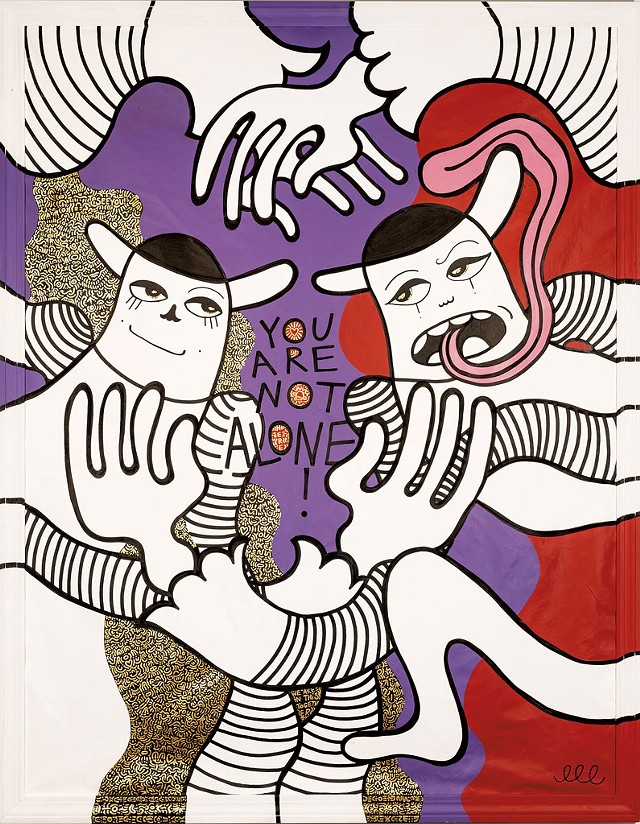
- Courtesy Of Liza Voll
- "You Are Not Alone!" by Liza Phillip
Art made by individuals with no formal training is known by many labels: art brut, outsider art, folk, visionary, self-taught. Heather Ferrell, the curator and director of exhibitions at Burlington's BCA Center, prefers "idiosyncratic."
That's an apt description of the work she included in the current exhibit "Outstanding: Contemporary Self-Taught Art." With a title that recasts the term "outsider" as praise, the show assembles highly personal works by eight artists. Six live in Vermont: Larry Bissonnette, Joseph "Chip" Haggerty, Liza Phillip, Pamela Smith, Thomas Stetson and Kalin Thomas. June Gutman lives in Montréal, Denver Ferguson in West Lebanon, N.H.
Self-taught does not mean unskilled or unoriginal; the BCA show is filled with inimitable work. Few people are likely to look at the suspended layers of muscle, abdominal cavity and organs of Stetson's screaming cadaver in "Delirium Tremens" and think they could readily create — or even conceive of — such work.

- Courtesy Of Liza Voll
- "Delirium Tremens" by Thomas Stetson
Stetson belongs to Burlington's Howard Center Arts Collective, whose members tackle mental health or substance-use challenges through creativity. His work, which can be difficult to witness, captures the feeling of pure agony on a level comparable to few other artists. (Francis Bacon comes to mind.) Yet Stetson's laborious detail compels a viewer to look more closely.
"Phase 2: 5/5/12-2/8/14" and "Phase 3: 2/8/14-9/9/19" are two clothbound books Stetson created that resemble funerary relics. The cover of one, showing a face that appears to be melting, is framed with the skeletal jaw of an unidentified animal, teeth intact. All visible parts of the book are blackened, torn or made to look aged. A chain connecting the covers suggests the object is a repository of secrets taken to the grave.
Phillip takes a sunnier approach to art making. Black and queer, they employ a graphic style of heavily outlined, imagined figures that recalls the work of local comic book artist James Kochalka and street artist Keith Haring but is entirely their own. The interwoven figures, genderless with blunt horns and ribbon tongues, cradle and sometimes bear their hopeful messages in writing.
"You Are Not Alone!" depicts black and white figures on a red and purple background and is packed with affirmations worked into a swath of gold: "i see you," "i love you," "we are in this together." The work literally bursts its boundaries: The painting continues over the frame.
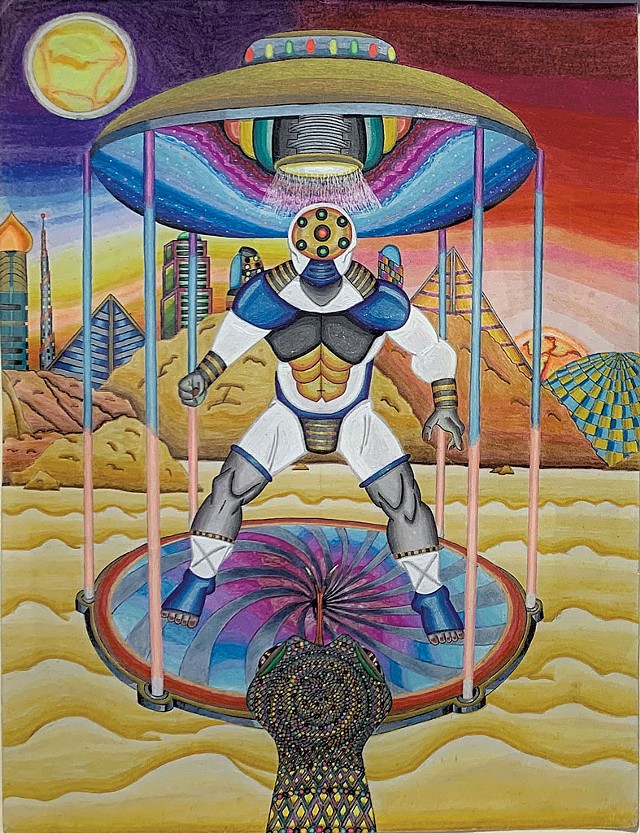
- Amy Lilly
- "Carousel Protector of the Seven Worlds" by Denver Ferguson
Ferguson, from the U.S. Virgin Islands, references Afrofuturism in colored pencil, graphite and pen drawings. His muscular, suited and helmeted figures have wide stances, as if ready to take on an enemy.
One such figure, in "Carousel Protector of the Seven Worlds," may be intended to depict a force equal to the destructive hurricanes that prompted Ferguson's 2017 relocation to the Upper Valley, where his daughter lives. That's when he began drawing, and his work was soon picked up by Kishka Gallery & Library in White River Junction. Kishka's owners took Ferguson's work to the 2023 Outsider Art Fair in New York City, where it was named a "best booth" by ARTnews.

- Amy Lilly
- "Snood's Mildred" by June Gutman
Gutman, too, explores imaginative realms in her graphite, colored pencil and acrylic works on paper. A self-described survivor of psychiatric treatment, she portrays dreamlike scenes and symbols in symmetrical compositions. Some are obscure: "Snood's Mildred" may come from the Snood video game. Yet its central figure resembles a classical nude, and "Ode to El Greco #2" refers to the famous 16th-century artist of the Spanish Renaissance.
In its original formulation, art brut — a term coined by French artist Jean Dubuffet in the 1940s — was supposed to encompass art made by people outside the strictures of artistic traditions, including prisoners, children and psychiatric patients. (In 1972, British critic Roger Cardinal translated the term as "outsider art.") Curator Ferrell hopes to widen the category by showing artists who have schooled themselves in "traditional" art.
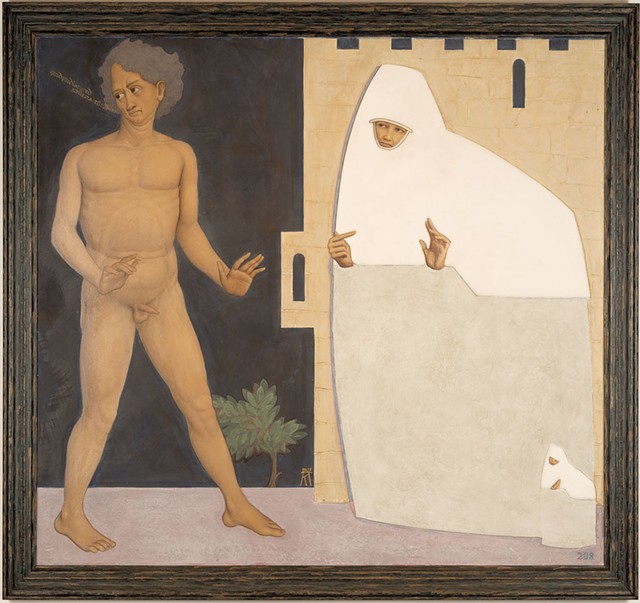
- Courtesy Of Liza Voll
- "Tre Volte Lei Gli Fece Le Avances è Tre Volte La Rifiutò" by Kalin Thomas
In that regard, the artist with the deepest immersion in art history is Thomas; his paintings openly draw from and combine elements of early Renaissance through baroque masterpieces.
"Frontiers in Lobotomy," for instance, is a tondo — a circular painting reserved during the Renaissance for depictions of the Madonna and Child. Thomas uses it to frame a female figure reclining on a ground of blooming flowers, while a solid cloud containing men's white-bearded heads and gesturing hands hovers above.
The pastel-colored late-medieval town in the background recalls Ambrogio Lorenzetti's frescos from 1338 inside the town hall in Siena, Italy; the precisely rendered flowers, Hubert and Jan van Eyck's Ghent altarpiece from 1432.
"I look at and consume so much art material, it's not like I'm an outsider artist," Thomas said by phone.
He uses historical elements to immerse viewers in ambiguity rather than present a new narrative. While he didn't study art formally, as a linguistics major in college Thomas learned that "elements of communication can be broken up, changed, manipulated and put back together with new meaning," he said. That approach is evident in his compositions, which he constructs with laborious care.
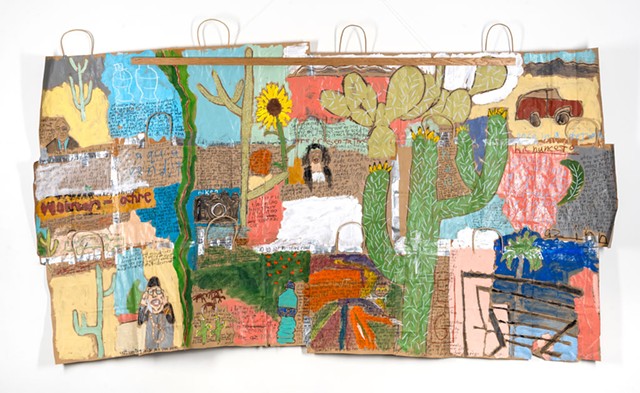
- Courtesy Of Liza Voll
- "AZ (Arizona)" by Chip Haggerty
By contrast, Haggerty's paintings on upcycled brown paper bags resemble dashed-off stream-of-consciousness musings, dense with written recollections surrounding everyday imagery. The pieces present their maker as an artistic naïf, yet often art viewing is his subject: "St. Louis Crossword" mentions "Renaissance perspective lines" and "the Alex Katz show at the Guggenheim." Haggerty's "AZ (Arizona)" recounts being driven via Uber to the "yun gee park gallery which was mind-blowing! curatorial nirvana."
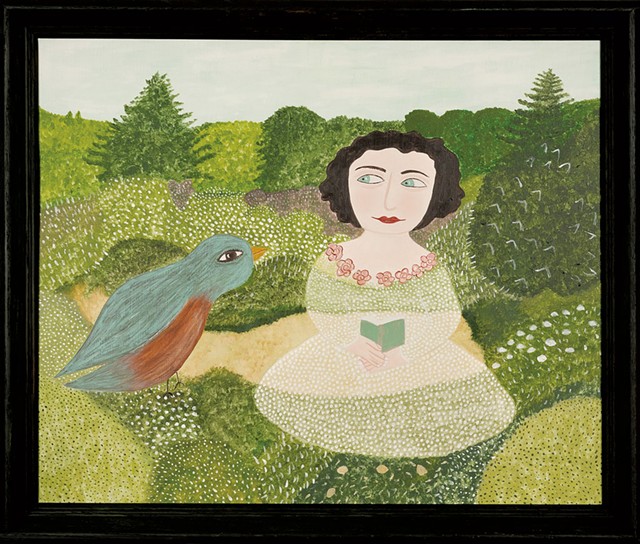
- Courtesy Of Liza Voll
- "Do Tell" by Pamela Smith
Smith's flat-perspective, folk art-influenced paintings may be familiar to Vermonters through previous exhibits at the Kent Museum in Calais or the Northern Daughters gallery in Vergennes — NoDa cofounder Sophie Pickens is Smith's daughter. The artist's colorful, female-centric scenes suggest brief, playful narratives: a conversation between a woman holding a book and a bird in "Do Tell," a fox draped in a lacy veil in "Sly Bride."
Smith creates patterns from the leaves and vines that weave through her work. These natural elements unite the three figures of her papier-mâché sculpture "Holding Love." The American Visionary Art Museum in Baltimore has acquired similar Smith works.
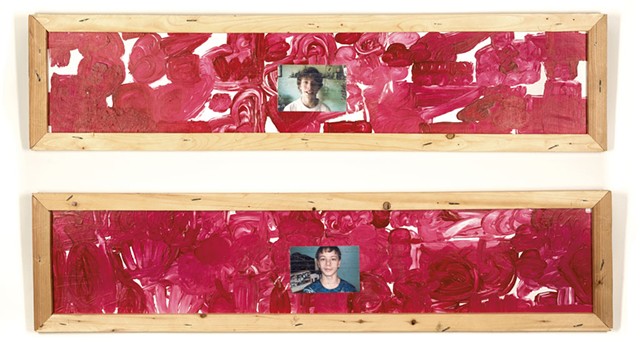
- Courtesy Of Liza Voll
- From top: "Larry loves pretty pink color in his paintings. People pictures like to nestle in pink colored world"; "Other People Like Less Pretty Colors. Larry's Little Nephew Pleased With Pink as His Patterned Background" by Larry Bissonnette
Bissonnette's long, horizontal paintings, hand-framed in rough wood, are more abstract with swirls of thick paint — except for the small photograph of an acquaintance affixed to the center of each. According to Saint Michael's College associate professor of music William Ellis, who wrote an article on Bissonnette for Folk Art Messenger, the Folk Art Society of America magazine, the artist sometimes takes years to match a photograph with a painting. He then devises playful titles such as, in the BCA show, "Other People Like Less Pretty Colors. Larry's Little Nephew Pleased With Pink as His Patterned Background."
Bissonnette is a prolific painter on the autism spectrum who communicates through his art and, when language is needed, through an iPad with a text speech app. He is also a disability rights advocate and the subject of two documentary films, My Classic Life as an Artist (2005) and Wretches & Jabberers (2011). Ellis wrote that Bissonnette doesn't make "autistic art"; "rather, his art speaks past autism to share the humanity of a person whose diagnosis inhibits typical communication of feelings, thoughts, and ideas."
Self-taught art changes a gallery space, introducing the idea that ordinary people's work deserves as much scrutiny and appreciation as that of highly trained artists. In a review of a 2015 American Folk Art Museum exhibition drawn from Dubuffet's massive art brut collection, the late critic Peter Schjeldahl wrote that the French artist "aspired not to make outsiders respectable but to destroy the complacency of insiders."
The BCA's "Outstanding" exhibition goes beyond that, inspiring true admiration.









Comments
Comments are closed.
From 2014-2020, Seven Days allowed readers to comment on all stories posted on our website. While we've appreciated the suggestions and insights, right now Seven Days is prioritizing our core mission — producing high-quality, responsible local journalism — over moderating online debates between readers.
To criticize, correct or praise our reporting, please send us a letter to the editor or send us a tip. We’ll check it out and report the results.
Online comments may return when we have better tech tools for managing them. Thanks for reading.